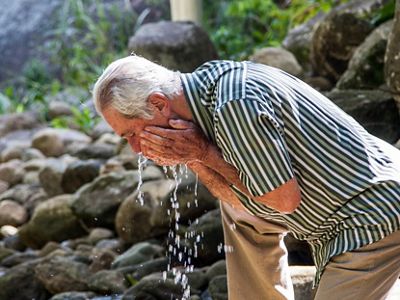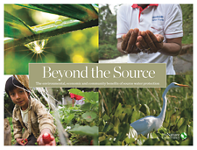A Natural Solution to Water Security
Report analyzes 4,000 cities to demonstrate the health, climate and biodiversity benefits of source water protection
When you turn on the tap in Quito, Ecuador, the water that emerges does so after a long journey. It starts high in the Andes, in springs and streams that merge into rivers, and flows downhill.
There, the water filters through cloud forests and grasslands, picking up more spring water and snowmelt from glaciers, continuing its downstream journey until it eventually reaches Quito’s municipal water system.
Download the Report
Quote
Source water protection could cost just $2 per person per year.
The quality of the water entering Quito, and many other cities around the world, is directly dependent on the landscapes through which the water flows. Good land management can promote water filtration, produce more reliable downstream flows, and reduce the amount of sediments and nutrients that can make their way into the rivers, springs and aquifers that feed urban water supplies. The city of Quito and upstream landholders have invested in taking care of their water sources for many years.
Unfortunately, many of our lands around the world are not always managed well, which leads to impaired downstream water quality and flows. Deforestation, poor agricultural practices and other land uses have led to moderate to high degradation in 40 percent of the world’s urban source watersheds. Water quality and quantity challenges have typically been met with the addition of more gray infrastructure—including aqueducts, reservoirs and treatment plants—to move and treat water for human and industrial purposes.
But the path to water security doesn’t have to be lined exclusively in concrete. Improving the health of the lands around our water sources—a strategy called source water protection—can improve water quality, restore reliable water flows and bring added benefits to local ecosystems and communities.
Download the Summary







Quote
Source water protection could reduce CO2 emissions by 10 gigatonnes annually.
There are many effective source water protection activities, including forest protection, reforestation and improvement of agricultural practices on lands near water sources.
To implement these strategies, The Nature Conservancy is working with cities and water users around the world to create water funds, which enable water users to collectively invest in source water protection activities for the purpose of securing better water quality and improving the health and well-being of local communities. The Conservancy and its partners already have 29 water funds in operation and another 30 in development. The first of these was created more than 15 years ago—in Quito.
“Communities downstream are going to benefit if their water comes when they want it and how they want it,” said Andrea Erickson, managing director for water security at The Nature Conservancy. “Source water protection can provide that connection between downstream users and upstream individuals—the farmers, ranchers and other community members that are a critical part of the solution.”
At a time when there is growing demand for limited water supplies—and when climate change is making availability of water even more uncertain—source water protection is a powerful strategy to not only secure clean water but also mitigate and adapt to climate change, protect biodiversity, and support human health and well-being across watersheds.
View this video in Spanish, Portuguese, Chinese and French as well.
Beyond the Source
Download ReportWhat Are the Benefits of Source Water Protection?
Source water protection is first and foremost a strategy for securing clean, reliable natural water sources. The benefits of this approach are documented in “Beyond the Source: the environmental, economic and community benefits of source water protection,” a report developed by The Nature Conservancy in partnership with the Natural Capital Project, Forest Trends, the Inter-American Development Bank and the Latin American Water Funds Partnership. (Download the executive summary)
This global analysis demonstrates that four out of five of the more than 4,000 cities studied could meaningfully reduce sediment and nutrient pollution in the water they use through three source water protection activities—reforestation of pastureland, forest protection and the planting of cover crops.
In many cases, source water protection can pay for itself through water treatment savings. The Conservancy found that one in six of the cities studied could see a positive return on investment in source water protection through reduced annual treatment costs alone. But even cities that don’t break even on utility costs may realize great value through the other benefits that source water protection offers for people living in and around upstream watersheds and for the natural ecosystems that these watersheds support.
MITIGATES CARBON EMISSIONS
Restoring and protecting forests, which filter water and help to control runoff, are two of the most effective strategies for ensuring clean water for downstream users. But these practices also have the added benefit of capturing and avoiding the release of carbon into the atmosphere, helping to mitigate climate change. With 64 percent of the total carbon in tropical above-ground biomass located in source watersheds, preserving these ecosystems is a vital part of a comprehensive mitigation strategy.
This is happening in the Guandu watershed in Brazil, which supplies drinking water for 8 million people in Rio de Janeiro. Deforestation in the watershed, driven by farming and ranching, had contributed to a steep decline in water quality. The Guandu Water Producer Project, launched in November 2008, collects fees from downstream users, which are used to compensate farmers and ranchers for reforesting their lands and leaving existing riparian forests standing. The result is both cleaner water in Rio and less carbon released into the atmosphere.
“Since I have about six hectares of reforestation, when the forest is grown I’ll trap about 600 tons of carbon,” says Carlos Alberto Marques, a retired farmer participating in the project. “And I am very small. Now, imagine if all the large landowners in this country did a little bit of what I’m doing here with my partners.”
ENHANCES CLIMATE RESILIENCE
In addition to mitigating climate change, many source water protection measures can also help communities adapt to climate change impacts today and in the future. Changes in the hydrological cycle driven by climate change have resulted in increased incidences of both drought and flooding. Models predict increased soil erosion in 83 percent of source watersheds by mid-century and increased fire frequency in 24 percent.
It’s a scenario already evident in northern New Mexico, which is experiencing hotter, drier and longer fire seasons. These conditions are particularly dangerous in forests that are overgrown from fire suppression, where a wildfire can all but eviscerate the landscape.
“When these overgrown forests burn, they burn way too hot and destroy the headwater forests that are so critical for downstream users,” says Laura McCarthy, senior policy advisor for forest and fire restoration at The Nature Conservancy.

When rains do come, water can more easily rush over the scorched land, which can result in flash floods that inundate the Rio Grande River with sediment, debris and ash—affecting water quality downstream.
In response to this heightened threat, a coalition of land owners, government agencies, nonprofits and private companies have come together to invest in stream restoration, flood control, tree thinning and other wildfire management techniques.
These measures are proving much less expensive than treating water after it’s been polluted, and the fire control measures are reducing risk for nearby communities.
IMPROVES HUMAN HEALTH AND WELL-BEING
A clean water supply is a crucial part of any healthy community, but source water protection also contributes to human well-being in other ways. Some source water protection activities can reduce the transmission of water-borne diseases. They can also protect natural habitat for bees and other pollinating insects, which are crucial for the production of fruit and vegetable crops that deliver essential micronutrients to millions of people around the world.

More than 28 million farming households around the world could see potential improvements in crop production and increased longevity of their farms if source water protection activities were implemented throughout watersheds.
In Colombia’s Cauca Valley, small landowners are learning to use agroforestry and silvopasture practices, which involve growing crops and grazing livestock in areas interspersed with trees and other vegetation.
The strategy reduces sediment runoff, preserves natural habitat and improves long-term soil health, while also bolstering food security and incomes through increased agricultural output for many families.
Maria Esmeralda Marcillo, a farmer in the Cauca valley, describes her experience: “They educated us on how the trees aided preservation of water. Avocado trees have been good for the soil, and also to feed ourselves, to sell and to support my family.”
SUPPORTS BIODIVERSITY
Source water protection has important benefits for nature, too. More than three-fourths of urban source watersheds are within regions of high species diversity combined with high concentrations of species unique to those regions. But deforestation and other changes in land use are major threats to these ecosystems. In fact, according to WWF, tracked animal species populations in freshwater systems have declined by a staggering 81 percent over the last 40 years. Source water protection can play an important role in protecting habitat for both terrestrial and aquatic plant and animal species.

The same reforestation projects and changes in farming practices that are improving water quality and storing carbon in Brazil’s Guandu watershed, for example, are also contributing to the conservation of native plant and animal species populations. Both rare and representative species have been found in surveys of areas where habitats are being restored and protected.
Marques describes what he’s seen in the Guandu watershed: “Through reforestation, native trees are being planted, which are sources of food for these animals, and they are returning.”
Water Funds: A Mechanism for Realizing Source Water Protection
A key question, of course, is how to fund source water protection. The Conservancy estimates that an increase in annual global spending on ecosystem service programs between US$42 billion and US$48 billion would be required to achieve a 10 percent reduction in sediment and nutrient pollution in source watersheds worldwide. This level of spending could improve water security for at least 1.4 billion people. However, the question of who should bear that cost remains.
Quote
1.4 billion people could benefit from improved water security.
This is where the water fund enters the equation. Water funds provide a mechanism for downstream users to directly or indirectly compensate upstream users for activities that deliver water benefits to the payer.
Public and private water users, including businesses, utilities and local governments, invest collectively in conservation of the watersheds from which they source their water.
In fact, for half of the cities that the Conservancy studied, such a mechanism could fund source water protection activities at a cost of just US$2 or less per person per year.
Nairobi, Kenya, offers a good example. The conversion of forests and wetlands to agricultural uses in the Upper Tana River watershed, which supplies Nairobi’s water, has led to heavy sedimentation in the river—reducing the capacity of reservoirs, impacting the delivery of water to Nairobi water users and limiting hydropower generation during low-flow periods.
A number of water users and conservation groups, including the Nairobi City Water and Sewerage Company, The Nature Conservancy and the Kenya Electricity Generating Company, came together to establish the Upper Tana-Nairobi Water Fund, which is currently working with over 15,000 farmers in the watershed, providing funding and training to help farmers improve their land management practices. By planting cover crops and digging trenches that trap soil runoff, farmers are able to improve their crop yields while also reducing sedimentation in the Tana and other rivers.
Quote
5,408 species could see reduced risk of extinction through watershed reforestation.
“We always realized green infrastructure would be a part and parcel of our operation,” says Philip Gichukki, managing director of the Nairobi City Water and Sewer Company. “When the idea of the water fund came about, we were excited because we found it was possible for us to engage with everybody involved in water catchment conservation, and it was possible to pool together the resources of people whose businesses relied on water along with those of us who manage the water.”
Bringing Communities and Partners Together for Shared Benefit
Successful source water protection strategies require the cooperation of parties both upstream and downstream, including landowners, governments, corporations, NGOs and many others with seemingly disparate interests. But these strategies are effective precisely because they can generate benefits for all these stakeholders.
“The most important component for a successful water fund is understanding the value of the engagement it provides for people,” Erickson says. “Everyone will come to the table when they understand that they really have something to gain.” (Watch more from Andrea Erickson here.)

McCarthy agrees. Source water protection is effective, she says, because “people are ready for big scale solutions that unite everyone in working on a problem together.”
Source water protection shows that even economic development and nature preservation can be achieved together. The Rio Grande Water Fund in New Mexico, which has 53 signatory organizations, has created 70 new jobs in its first year of operation and project managers estimate that 300 to 600 seasonal forest worker jobs will be created annually in the future.
Reforestation work in Brazil’s Guandu watershed has created more than 300 new formal jobs and another 350 informal jobs. Many of the jobs in Guandu are being filled by people who were previously working in illegal logging—a win for the community and for nature.
Achieving these win-win situations is crucial for the next generation, says Debora Dos Santos Leite, principal at the Rio das Pedras Municipal School in Brazil. “Nature is everything to people. It is life. It is the future of the generation that we have here, the very little ones. Everyone is grateful for the work we are doing because, in addition to bringing benefits to the families and to the community, the greatest benefit is to the children."
For more information on the Beyond the Source report and its findings, please contact us.
Report Downloads
Download the Beyond the Source report, as well as the executive summary below. You can also download the executive summary in the following languages: Portuguese, Spanish, Chinese and French.
Download
Water Funds Toolbox
The Nature Conservancy and its partners hold nearly 20 years of experience developing water funds, and have centralized this experience into a step-by-step web-tool to help local champions replicate and implement the water funds model.

Local Spotlights
Learn more about the benefits of source water protection from select cities. View and download local spotlights from Bloomington, Illinois; Cauca Valley, Colombia; Monterrey, Mexico; Nairobi, Kenya; Rio De Janeiro, Brazil; Rio Grande, New Mexico; Rio Yaque del Norte, Dominican Republic; San Antonio, Texas; Santa Cruz Valleys, Bolivia; and São Paulo, Brazil.

Infographic: Nature's Solution to a Sustainable Water Future
This infographic can be viewed here.
Additional Infographics:
Nature Improves City Water
Nature Helps Farms, Fisheries and Water

Illustration: Healthy Lands, Healthy Water
This illustration on how natural infrastructure can be a path to clean water can be viewed in full here.
Videos: The Benefits of Source Water Protection
Watch the video to the left on the Nairobi Water Fund, and see below for additional water fund videos.
- Nature’s Role in Maintaining Water Quality and Quantity
- The Nairobi Water Fund: A First for Africa
- The benefits of source water protection: Brazil
- The benefits of source water protection: Guatemala
- The benefits of source water protection: Ecuador
- The benefits of source water protection: New Mexico, United States
- The benefits of source water protection: Chile


